
Willem Drost was a Dutch Golden Age painter and printmaker of history paintings and portraits.

Lucian Michael Freud was a British painter and draughtsman, specialising in figurative art, and is known as one of the foremost 20th-century English portraitists. He was born in Berlin, the son of Jewish architect Ernst L. Freud and the grandson of Sigmund Freud. Freud got his first name "Lucian" from his mother in memory of the ancient writer Lucian of Samosata. His family moved to England in 1933 to escape the rise of Nazism. From 1942 to 1943 he attended Goldsmiths College, London. He served at sea with the British Merchant Navy during the Second World War.

Carel Pietersz. Fabritius was a Dutch painter. He was a pupil of Rembrandt and worked in his studio in Amsterdam. Fabritius, who was a member of the Delft School, developed his own artistic style and experimented with perspective and lighting. Among his works are A View of Delft, The Goldfinch (1654), and The Sentry (1654).

George Romney was an English portrait painter. He was the most fashionable artist of his day, painting many leading society figures – including his artistic muse, Emma Hamilton, mistress of Lord Nelson.
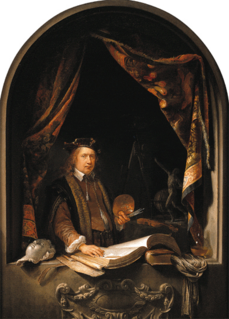
Gerrit Dou, also known as GerardDouw or Dow, was a Dutch Golden Age painter, whose small, highly polished paintings are typical of the Leiden fijnschilders. He specialised in genre scenes and is noted for his trompe-l'œil "niche" paintings and candlelit night-scenes with strong chiaroscuro. He was a student of Rembrandt.

Portrait of a Young Man is a tempera on panel painting by the Italian Renaissance artist Sandro Botticelli, c. 1483. It is housed in the National Gallery in London.
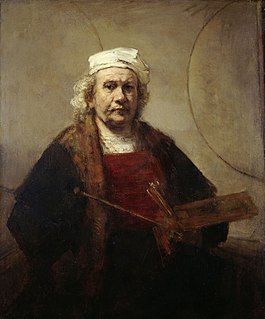
A self-portrait is a representation of an artist that is drawn, painted, photographed, or sculpted by that artist. Although self-portraits have been made since the earliest times, it is not until the Early Renaissance in the mid-15th century that artists can be frequently identified depicting themselves as either the main subject, or as important characters in their work. With better and cheaper mirrors, and the advent of the panel portrait, many painters, sculptors and printmakers tried some form of self-portraiture. Portrait of a Man in a Turban by Jan van Eyck of 1433 may well be the earliest known panel self-portrait. He painted a separate portrait of his wife, and he belonged to the social group that had begun to commission portraits, already more common among wealthy Netherlanders than south of the Alps. The genre is venerable, but not until the Renaissance, with increased wealth and interest in the individual as a subject, did it become truly popular.

Portrait of a Lady is a small oil-on-oak panel painting executed around 1460 by the Netherlandish painter Rogier van der Weyden. The composition is built from the geometric shapes that form the lines of the woman's veil, neckline, face, and arms, and by the fall of the light that illuminates her face and headdress. The vivid contrasts of darkness and light enhance the almost unnatural beauty and Gothic elegance of the model.

Self-Portrait with Beret and Turned-Up Collar is a 1659 oil on canvas painting by the Dutch artist Rembrandt, one of over 40 self-portraits by Rembrandt. It has been noted as a self-portrayal of subtle and somber qualities, a work in which may be seen "the stresses and strains of a life compounded of creative triumphs and personal and financial reverses". Once owned by Andrew W. Mellon, it has been in the National Gallery of Art since 1937.

A Man with a Quilted Sleeve is a painting of about 1510 by the Venetian painter Titian in the National Gallery, London, measuring 81.2 by 66.3 centimetres. Though the quality of the painting has always been praised, there has been much discussion as to the identity of the sitter. It was long thought to be a portrait of Ariosto, then a self-portrait, but in 2017 is called Portrait of Gerolamo (?) Barbarigo by the gallery, having also been called merely Portrait of a Man, the title used here, The Man with the Blue Sleeve, and no doubt other variants.
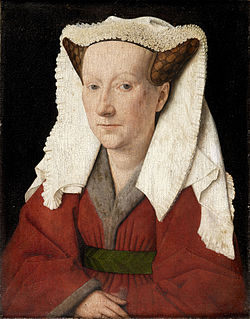
Portrait of Margaret van Eyck is a 1439 oil on wood painting by the Early Netherlandish master Jan van Eyck. It is one of the two latest of his surviving paintings, and one of the earliest European artworks to depict a painter's spouse. Completed when she was around 34, it was hung until the early 18th century in the Bruges chapel of the Guild of painters. The work is thought to be a pendant or diptych panel for either a now lost self-portrait known from records until 1769, or of Jan van Eyck's likely self-portrait now in the National Gallery in London.
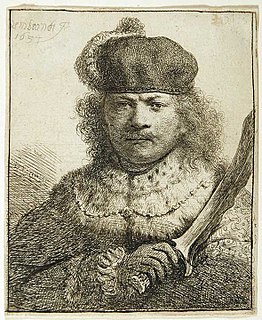
The dozens of self-portraits by Rembrandt were an important part of his oeuvre. Rembrandt created approaching one hundred self-portraits including over forty paintings, thirty-one etchings and about seven drawings; some remain uncertain as to the identity of either the subject or the artist, or the definition of a portrait.
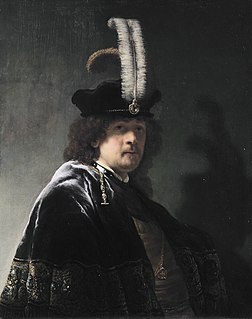
Self-portrait wearing a white feathered bonnet is an oil painting attributed to the Dutch painter Rembrandt. It is signed and dated 1635. It was traditionally regarded as a Rembrandt self-portrait until 1968, when it was rejected on stylistic grounds in the Rembrandt catalogue raisonné by Horst Gerson. In 2013, art historian Ernst van de Wetering re-attributed the painting as an original Rembrandt. It is one of over 40 painted self-portraits by Rembrandt.

Portrait of a Man is an oil painting by the Italian Renaissance artist Antonello da Messina, dated to c. 1475–76, and now in the National Gallery, London. It was printed on the Italian 5,000 lire note issued from 1979 to 1983.

A Polish Nobleman is a 1637 painting by Rembrandt depicting a man in a costume of Polish szlachta (nobility). The identity of the subject of the painting is unclear, and has given rise to several different interpretations. The view that the figure's dress is clearly Polish is not universally held and it may have been a self-portrait.

Self-Portrait at the Age of 63 is a self-portrait by the Dutch artist Rembrandt. One of three dating to 1669, it was one of the last in his series of around 80 self-portraits, painted in the months before his death in October 1669. Despite the closeness of his death, and the concentration on his aging face, Rembrandt makes an impression of a self-assured and confident artist. It was bought by the National Gallery, London in 1851.

Self-Portrait at the Age of 34 is a self-portrait by Rembrandt, dating to 1640 and now in the National Gallery in London. The painting is one of many self-portraits by Rembrandt, in both painting and etching, to show the artist in a fancy costume from the previous century. In this case specific influences in the pose have long been recognised from Raphael's Portrait of Baldassare Castiglione and Titian's A Man with a Quilted Sleeve in the National Gallery. Rembrandt saw both of these in Amsterdam, in his day the centre of Europe's art trade, and made a sketch of the Raphael, with its price.
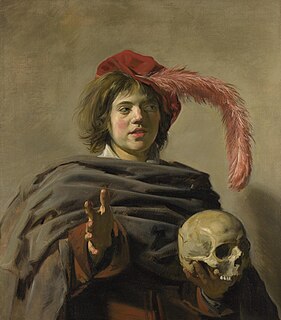
Young Man with a Skull is a c.1626 painting by the Dutch Golden Age painter Frans Hals, now in the National Gallery, London. The painting was previously thought to be a depiction of Shakespeare's Hamlet holding the skull of Yorick, but is now considered to be a vanitas, a reminder of the precarious nature of life and the inevitability of death.

Self-Portrait with Bandaged Ear is an 1889 self-portrait by Dutch, Post-Impressionist artist Vincent van Gogh. The painting is now in the collection of the Courtauld Institute of Art and on display in the Gallery at Somerset House.



















